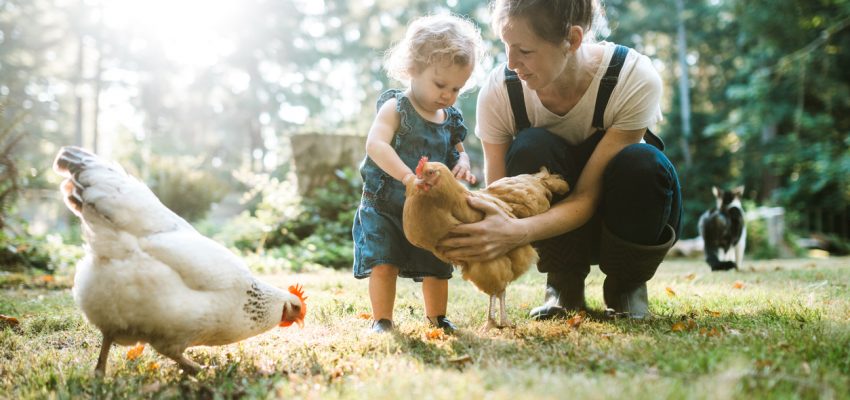There’s a lot to love about keeping chickens – they produce eggs daily and their egg shells and poop are great for nutritious soil. Quail are a great alternative to chickens. Raising quail requires less space and they tend to make less noise than chickens, which is ideal if you don’t want to disturb neighbors. Keeping chickens can be a rewarding (and delicious) hobby, but they do require a large initial outlay to get the coop and fencing up. They require daily upkeep and attention and they need to be protected from predators. However, the joy of collecting your own fresh eggs makes it all worth the effort.

Chickens are good at keeping your garden pest infestations at bay, but they can also damage plants and vegetables if left unattended. Let your chickens have the run of the garden in the fall. They will peck at weed seeds, scratch the soil to help with aeration and they will eat any leftover vegetables, plant matter and bugs.
You will need to keep your chickens safe from predators which are plentiful, even in residential areas (think foxes, owls, hawks, cats, fishers, etc.)
Chickens are a daily responsibility too. They need to be fed and watered and you’ll need to scoop poop from the coop regularly. Still want chickens? Then check with your local town ordinances to see if you are allowed to keep chickens in your neighborhood.
Your chickens will lay spring through fall as long as they are getting 12-14 hours of sun. On average, healthy adult birds lay about 2 eggs every 3 days. That means a small backyard coop for a single family should house 3-6 birds. The birds lay eggs regularly through the first two years of their lives and then production will begin to slow. You need to decide what will happen to your aging birds and when to introduce younger hens.
Coop Dreams
You will need enough space to house your chicken coop. The size of your coop depends on how many birds you want to keep and how much room you have in your yard. Ensure your coop is cool during the summer months and warm in the winter with plenty of air ventilation. Ensure you have 1 nesting box for every three chickens – more is even better! Here are some free DIY chicken coop designs:
- The Farmer’s Almanac
- Backyard Chickens
- The Happy Chicken Coop
- Chicken Mansion from Backyard Chickens
- My Outdoor Plans
As a rule of thumb, each medium-sized chicken needs 3 square feet of floor space in the coop and 8-10 feet of outdoor space. More space will mean happier chickens and less likelihood of pecking and pests.
Breeds
There are hundreds of chicken breeds and you should choose one that best suits your needs and climate. Chickens can be divided into these broad categories:
Heritage: These are natural breeding chickens that are perfect for slow growth rates and long, productive lives.
Egg layers: These chickens are great layers and produce lots of eggs for a short period of time. They will need to be regularly replaced.
Meat breeds: These have been engineered for short lifespans. They a grow at an alarming rate and will be ready for slaughter at around 9 weeks.
Dual purpose: These chickens are great egg layers who put on enough weight to be meat chickens when they are no longer productive.
Food and Water
Each mature chicken drinks about 1 cup of water a day. The hens will drink small sips throughout the day – insufficient water will affect egg production and growth. Drinkers are an efficient and proven way to deliver clean water effectively.
You will need a chicken feeder and the right food for your chickens. Consult your local supplier to get the right food mix for your chickens. The right food will increase weight and production while the wrong food can lead to weight loss, poor egg production and illness.





продажа аккаунтов платформа для покупки аккаунтов
Website for Selling Accounts Verified Accounts for Sale
website for selling accounts buy pre-made account
accounts for sale https://accountsmarketdiscount.com/
account store account acquisition
sell account marketplace for ready-made accounts
account selling platform sell account
profitable account sales accounts market
account selling service https://social-accounts-marketplace.live/
account sale accounts-marketplace-best.pro
buy fb ad account https://buy-ads-account.click/
fb account for sale https://buy-ad-account.click
buy facebook advertising accounts https://buy-accounts.click/
buy google ad threshold account buy verified google ads account
buy verified facebook facebook business manager for sale
buy fb business manager verified-business-manager-for-sale.org
tiktok ads agency account https://buy-tiktok-ads-accounts.org